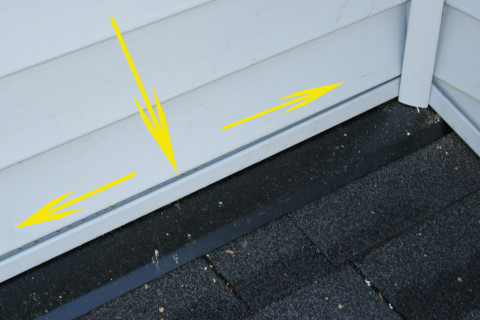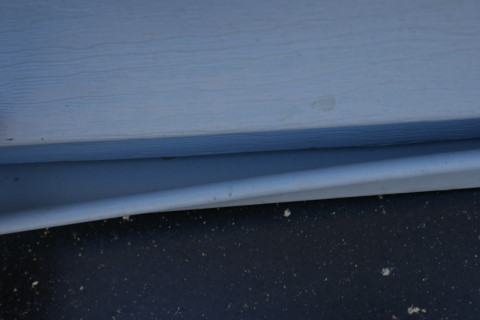Have you ever seen vinyl J channel used at the bottom of a wall and wondered where the water caught in the channel will go? Well, it runs sideways until it gets to a joint in the J channel or a corner intersection where it’ll weep out. If these areas are flashed correctly then there’s no problem. So let’s take a look at a few photos to begin our discussion.
In this photo above you can see how water flowing down the wall will be caught in the j channel where it will flow sideways until it finds an exit path. If the corner in this picture is not flashed correctly from underneath the J channel then moisture might penetrate the structure.
Actually the proper way to start horizontal vinyl is to use a metal starter strip. In this way no J is used and water flows directly off the siding. However; to use a starter strip you have to start with a whole piece. Sometimes this isn’t possible because installers want to line the siding up to be even with other siding for aesthetic purposes or because the siding is being ran vertically. Also J channel used in this way can hide framing inconsistencies making for an easier better looking installation. So there are plenty of reasons to run the J channel at the bottom. It just needs to be done correctly.
In this photo you can see an actual home where moisture damage is occurring. Water was being diverted to the door where it was being absorbed by the building materials. Inside trim and sheetrock and door jambs were moisture damaged. Not knowing the real reason for the moisture damage might make someone spend more money on ineffective remedies like replacing the door or adding a storm door for example. I happen to know that in this case another inspector had failed to advise his client about this installation deficiency. In this case using J channel at the bottom was unnecessary because they started with a whole piece which means they could have used starter strip instead. However proper flashing at the corner is still needed either way.
The Solution
When vinyl J channel is used at the bottom like this proper flashing is essential especially at the corners. Also; 1/4 inch weep holes can be drilled about 12 inches apart into the J channel only where it is needed. This will help keep the track dry and prevent accumulation of unwanted moisture. Siding manufactures differ in their recommendations regarding the spacing of the holes and the size. Page 29 of the Vinyl Siding Institute’s Vinyl Siding Manual show how. An internet search will bring up the PDF.
This article was originally written on 9-26-2012 by Ray Thornburg




